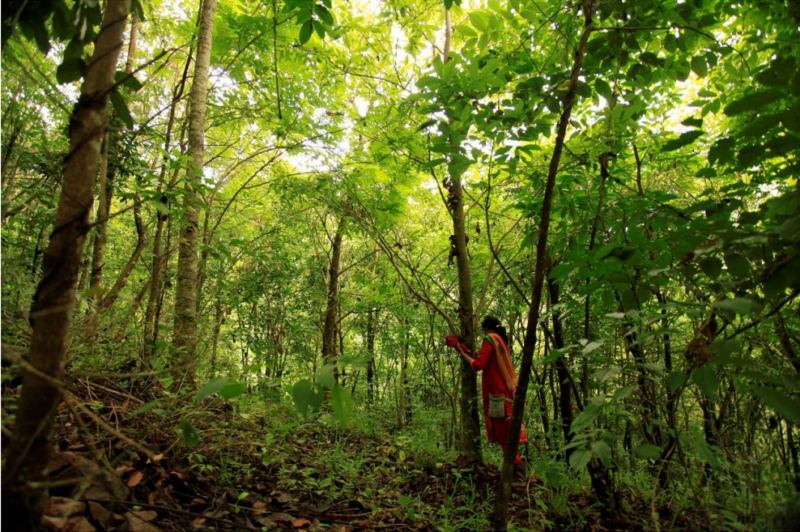
A decade ago, I had the experience of walking inside some of the densest forests in Western Ghats – One droplet of rain touches the tallest crown of the canopy and diffuses into a thousand droplets after making a touchdown on tree crowns at different levels, to finally fall on the forest floor. It feels like slow motion frozen in time. The spongy forest floor that has many years’ worth of leaf litter, soaks up those thousand droplets coming down in slow motion, falling on every crown, every leaf and every branch. After quenching its thirst, the leaf litter lets the excess flow down as streams and rivers. A whole diversity of organisms awaits us beneath the forest floor.
The large buttress root of a Hopea tree harvests water and extends its roots down into the steep slopes of the mountains. The morning sun falls faintly through the dense forest canopy on the understory cane. A small exposure of the soil surface makes me trip and there I hold on to the large trunk of a 300 year old grandmother tree that stands tall. I feel insignificant in front of so many such grandmothers who are nurturing the forests by sprouting a million seeds every year. The forest floor is full of seedlings of various heights and age, waiting for that opening in the canopy cover. The grandmother has to fall, releasing its nutrients locked up for centuries, for another sapling to grow into a tree. The fungal network below the forest floor is just another wonder of nature’s communication system. These dense forests are teeming with diversity of trees, shrubs, climbers, flowering plants and orchids apart from the largest diversity of insects, birds, reptiles and birds. These are ecosystems that have evolved over millions of years, untouched by humans.
I realised that I’m standing in one of the degraded forest patches of Western Ghats. Due to the clear felling of the grandmother trees – Chopped by the British for railway sleepers and all subsequent Indian Govts for building roads, power transmission lines and hydroelectric power – large gaping holes have been created in the forest cover , which has invited some of the most troublesome alien invasive species in the world : Lantana camara and Senna spectabilis. The forest floor is devoid of leaf litter to soak up the rain, there are gaping holes and the sun lands harshly, evaporating all the water that falls – the result is a dry cracked up soil in summer. There are no grandmother trees in an area of 5 sq km and all you see is thorny invasive Lantana on the forest floor. Once in a while an Amaltas and Palash makes a guest appearance in between a thicket of Lantana to remind us of the native species that can pioneer. Large areas of forest land is covered by invasive and a feeling of empathy flows out towards the tusker and primates that raided our farm a month ago. A true reminder that there is absolutely nothing for these mammals to feed on. Lantana and Senna is just a false green cover on the landscape that can offer no food to the beings that depend on that landscape. A by-product of the sin committed by humans for its greed for timber.
A vision of a million sprouting seeds came to my mind while sitting in silence. It felt like a strong urge by those grandmother trees to plant darkness in the landscapes of Western Ghats and claim their lost spaces. The 150 diverse species that we conserve have diverse growth patterns. To trigger that process of inviting rain; to trigger a process of covering up the forest floor with leaf litter; to trigger a process of inviting leeches and frogs; to trigger a process of attracting birds and bees for nectar; and the cycle goes on, sprouting a million more seeds.
Forest First started this journey of land restoration and habitat conservation a decade ago in 2008. In these 10 years of our journey we have restored sacred grove sites, planted diversity in Coffee estates, worked on forest land restoration and restored riparian buffer in Kodagu, Wayanad and Anekkatti. Those 150 diverse tree species will establish their territory on those degraded landscapes to once again attract pollinators and disperse wild edible fruits. This is the journey of tree species that can live up to more than 300 years. And these 10 years is just the beginning of that long and beautiful journey that nature is conspiring.
Meera Rajesh
(About the Author: Meera Rajesh has more than a decade of experience working with hill communities in restoration of forest lands and habitat conservation by conserving 150+ tree species of Western Ghats including RET. She works as a ‘Squirrel’ @ Forest First sowing seeds of environmental wisdom across communities.)


I was able to imagine the canopies and understand the powerful role they play in providing lead litter and moisture to the thriving eco system beneath. Deep bows to the beautiful work done by forest first. May nature take its rightful place. May the canopies reclaim their rightful crown.
Lovely Meera!
So happy to see you writting this down. More power to you!
Shardul